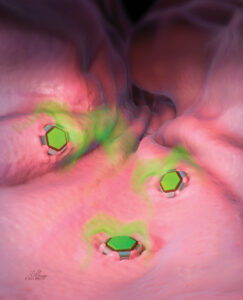
Inspired by a parasitic worm that digs its sharp teeth into its a host’s intestines, Johns Hopkins researchers have designed tiny, star-shaped microdevices that can latch onto intestinal mucosa and release drugs into the body.
Whiting School professor David Gracias and gastroenterologist Florin M. Selaru, director of the Johns Hopkins Inflammatory Bowel Disease Center, led a team that designed and tested shape-changing microdevices that mimic the way the parasitic hookworm affixes itself to an organism’s intestines.
The therapeutic grippers (or “thera-grippers”) are self-latching devices made of metal and a thin, residually stressed shape-changing film, then coated in heat-sensitive paraffin wax. The devices, each roughly the size of a dust speck, can potentially carry any drug and release it gradually into the body. When the paraffin wax coating on the grippers warms up inside the body, the miniscule devices close autonomously, clamping onto and digging into the mucosal colon wall, releasing their medicine payloads gradually. Eventually, they relax their grips and are cleared from the intestine via normal gastrointestinal muscular function.
“Our results provided the first in vivo evidence that shape -changing microdevices can enhance the efficacy of extended drug delivery and represent a new paradigm for smart therapeutics,” Gracias says.




